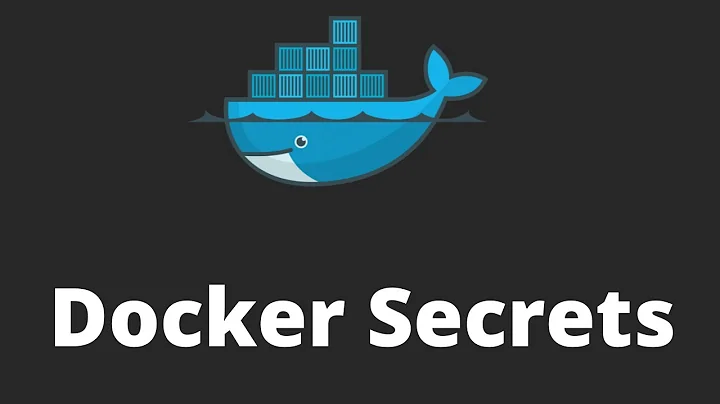Docker and securing passwords
Solution 1
Definitely it is a concern. Dockerfiles are commonly checked in to repositories and shared with other people. An alternative is to provide any credentials (usernames, passwords, tokens, anything sensitive) as environment variables at runtime. This is possible via the -e argument (for individual vars on the CLI) or --env-file argument (for multiple variables in a file) to docker run. Read this for using environmental with docker-compose.
Using --env-file is definitely a safer option since this protects against the secrets showing up in ps or in logs if one uses set -x.
However, env vars are not particularly secure either. They are visible via docker inspect, and hence they are available to any user that can run docker commands. (Of course, any user that has access to docker on the host also has root anyway.)
My preferred pattern is to use a wrapper script as the ENTRYPOINT or CMD. The wrapper script can first import secrets from an outside location in to the container at run time, then execute the application, providing the secrets. The exact mechanics of this vary based on your run time environment. In AWS, you can use a combination of IAM roles, the Key Management Service, and S3 to store encrypted secrets in an S3 bucket. Something like HashiCorp Vault or credstash is another option.
AFAIK there is no optimal pattern for using sensitive data as part of the build process. In fact, I have an SO question on this topic. You can use docker-squash to remove layers from an image. But there's no native functionality in Docker for this purpose.
You may find shykes comments on config in containers useful.
Solution 2
Our team avoids putting credentials in repositories, so that means they're not allowed in Dockerfile. Our best practice within applications is to use creds from environment variables.
We solve for this using docker-compose.
Within docker-compose.yml, you can specify a file that contains the environment variables for the container:
env_file:
- .env
Make sure to add .env to .gitignore, then set the credentials within the .env file like:
SOME_USERNAME=myUser
SOME_PWD_VAR=myPwd
Store the .env file locally or in a secure location where the rest of the team can grab it.
See: https://docs.docker.com/compose/environment-variables/#/the-env-file
Solution 3
Docker now (version 1.13 or 17.06 and higher) has support for managing secret information. Here's an overview and more detailed documentation
Similar feature exists in kubernetes and DCOS
Solution 4
You should never add credentials to a container unless you're OK broadcasting the creds to whomever can download the image. In particular, doing and ADD creds and later RUN rm creds is not secure because the creds file remains in the final image in an intermediate filesystem layer. It's easy for anyone with access to the image to extract it.
The typical solution I've seen when you need creds to checkout dependencies and such is to use one container to build another. I.e., typically you have some build environment in your base container and you need to invoke that to build your app container. So the simple solution is to add your app source and then RUN the build commands. This is insecure if you need creds in that RUN. Instead what you do is put your source into a local directory, run (as in docker run) the container to perform the build step with the local source directory mounted as volume and the creds either injected or mounted as another volume. Once the build step is complete you build your final container by simply ADDing the local source directory which now contains the built artifacts.
I'm hoping Docker adds some features to simplify all this!
Update: looks like the method going forward will be to have nested builds. In short, the dockerfile would describe a first container that is used to build the run-time environment and then a second nested container build that can assemble all the pieces into the final container. This way the build-time stuff isn't in the second container. This of a Java app where you need the JDK for building the app but only the JRE for running it. There are a number of proposals being discussed, best to start from https://github.com/docker/docker/issues/7115 and follow some of the links for alternate proposals.
Solution 5
An alternative to using environment variables, which can get messy if you have a lot of them, is to use volumes to make a directory on the host accessible in the container.
If you put all your credentials as files in that folder, then the container can read the files and use them as it pleases.
For example:
$ echo "secret" > /root/configs/password.txt
$ docker run -v /root/configs:/cfg ...
In the Docker container:
# echo Password is `cat /cfg/password.txt`
Password is secret
Many programs can read their credentials from a separate file, so this way you can just point the program to one of the files.
Related videos on Youtube
Comments
-
anthonator almost 2 years
I've been experimenting with Docker recently on building some services to play around with and one thing that keeps nagging me has been putting passwords in a Dockerfile. I'm a developer so storing passwords in source feels like a punch in the face. Should this even be a concern? Are there any good conventions on how to handle passwords in Dockerfiles?
-
Luís Bianchin over 8 yearsThere is an open issue on Github requesting for best practices regarding Docker and secrets, the issue is here: github.com/docker/docker/issues/13490
-
-
Petr Gladkikh over 9 yearsAs noted in other comments there will be 2 layers (after ADD and after first RUN) that contain
.configfile. -
gnoll110 over 9 yearsYer, env variables seems the best way to go. I've been looking at this in the context of TDDing Dockerfile development.
-
Lie Ryan over 8 yearsAccording to Docker's ARG docs: "It is not recommended to use build-time variables for passing secrets like github keys, user credentials etc"
-
 D. Visser over 8 yearsYou can also do this without a .env file, if you wish. Just use the environment property in your docker-compose.yml file . "Environment variables with only a key are resolved to their values on the machine Compose is running on, which can be helpful for secret or host-specific values."
D. Visser over 8 yearsYou can also do this without a .env file, if you wish. Just use the environment property in your docker-compose.yml file . "Environment variables with only a key are resolved to their values on the machine Compose is running on, which can be helpful for secret or host-specific values." -
equivalent8 about 8 yearsgive this man a cookie ! :) yep this is really good practice I just want to add that docs.docker.com/compose/env-file this should work automatically but in docker compose version 2 it seems you need to declare it as described in this answer.
-
Tomato almost 8 yearsI'm concerned that if your password is an env variable, it appears in
docker inspect. -
 Henk Wiersema over 7 yearsJust wondering why Docker disrecommends to use
Henk Wiersema over 7 yearsJust wondering why Docker disrecommends to use--build-arg var=secretfor passing a SSH private key into an image, there is no rationale documented. Can anyone explain it? -
tudor -Reinstate Monica- over 7 years@HenkWiersema Process information, logs and command history are insecure. Process information is available publicly and that includes all command line parameters. Frequently these calls end up in logs which can be public also. It's not uncommon for an attacker to inspect information on running processes and trawl public logfiles for secrets. Even when it's not public, it could be stored in your command history which would make it easy for someone to get secrets through a non-administrative account.
-
 ely about 7 yearsWhat is the recommended way to supply credentials that are needed at build time? For example, an image that needs aws s3 access to fetch a large data set that will reside inside the image?
ely about 7 yearsWhat is the recommended way to supply credentials that are needed at build time? For example, an image that needs aws s3 access to fetch a large data set that will reside inside the image? -
GrandOpener about 7 yearsA default installation of docker (on linux) requires sudoer privileges to run
docker inspect. If the attacker can already sudo, snatching your password out of docker inspect is probably pretty low on your list of things that can now go wrong. This particular detail seems like acceptable risk to me. -
vee_ess about 7 yearsI imagine the reason it is not recommended is because
docker historyexposesbuild-arg/ARGvariables. One can pull any image, inspect it and see any secrets passed during build as abuild-arg/ARGparameter. -
vee_ess about 7 years@GrandOpener That only applies to the situation where there is an attacker using your system. If I push a docker image to a repository, and it's pulled by someone else, I don't care if they have sudo on their own system but I definitely care if they see secrets in env that are no longer supposed to be there.
-
P.J almost 7 yearsSome useful commands from above links:
docker secret create: create a secretdocker secret inspect: display detailed information about a secretdocker secret ls: view all secretsdocker secret rm: remove a specific secret--secretflag fordocker service create: create a secret during service creation--secret-addand--secret-rmflags fordocker service update: update the value of a secret or remove a secret during service update task. Docker secrets are protected at rest on manager nodes and provisioned to worker nodes when during container startup. -
Heather QC almost 7 yearsYes, you need to set up a swarm to use Docker secrets
-
Jeff Lambert over 6 yearsThis is a good start on an answer, but needs much more information from that which is linked to appear in the answer itself.
-
pawamoy over 6 yearsUsing environment variables is discouraged by the Docker team itself, as env var can be seen through /proc/<pid>/environ and docker inspect. It only obfuscate the way to get the credentials for an attacker who has gained root access. Of course credentials should never be tracked by the CVS. I guess the only way to prevent a root-user to get cred is to read the credentials from within the web app (hoping that it does not update its proc environ file) from an encrypted file, the decryption process securely asking for a password. I think I'm gonna try with a tomb: github.com/dyne/Tomb
-
 aug70co over 5 yearsDo not use this method! It will leak sensitive information on docker history
aug70co over 5 yearsDo not use this method! It will leak sensitive information on docker history -
John Y over 5 yearsNot sure this can be the accepted answer if it only works with swarms. Many people aren't using swarms, but still need to pass secrets.
-
theUtherSide over 5 years
.gitignoreso that the.envfile with sensitive information does not get checked-in to GitHub. I'm pretty sure this won't work if you add it.dockerignore -
Groostav about 5 yearsIsnt one of the problems with environment params that they intrinsically get copied to all descendent's, including grand-child processes? Thus a script or a plugin used in your docker container would have access to these passwords by accident?
-
opensource-developer about 5 yearshi @theUtherSide, thanks for your answer, I had a question, when i dont checkin the
.envfile and I do a deployment to a server on premise, do you suggest to create the.envfile again on server manually? -
theUtherSide almost 5 yearsI would not recommend manually creating a
.envfile on a server...or doing anything manually on server for that matter. There are many ways/tools for this type of thing. -
 JakeCowton about 4 yearsI appreciate the reference to the bible.
JakeCowton about 4 yearsI appreciate the reference to the bible. -
 fsevenm about 3 years@theUtherSide it would be great if you can give us any examples or links of the "ways/tools" you meant.
fsevenm about 3 years@theUtherSide it would be great if you can give us any examples or links of the "ways/tools" you meant. -
 Swapnil Gangrade almost 3 yearsIf we use vault then where to store the vault secret id and role id which is used by the application to fetch credentialsmemory. How can we pass that into docker?
Swapnil Gangrade almost 3 yearsIf we use vault then where to store the vault secret id and role id which is used by the application to fetch credentialsmemory. How can we pass that into docker? -
 lnksz over 2 years"but not at build-time (building the image)," and then your example is for build-time! If you would use the mounted secret-file in the CMD pragma, then it would make sense.
lnksz over 2 years"but not at build-time (building the image)," and then your example is for build-time! If you would use the mounted secret-file in the CMD pragma, then it would make sense. -
Murmel over 2 years@lnksz Thanks, I adapted the example
-
 Robin Dinse over 2 yearsDocker Compose can manage secrets without a swarm. See this answer.
Robin Dinse over 2 yearsDocker Compose can manage secrets without a swarm. See this answer. -
 Robin Dinse over 2 yearsThis only worked with a prefix like this:
Robin Dinse over 2 yearsThis only worked with a prefix like this:DOCKER_BUILDKIT=1 docker-compose up -d -
Sebi2020 over 2 yearsThis is not very helpful as most of the out-of-the-box images expect passwords to be passed with environment variables
-
Sebi2020 over 2 yearsThis is a bad idea. especially typing in passwords into bash. All your secrets get stored into bash_history.
-
Malvineous over 2 yearsYes that's true, but I was only using it as an example of what the file contents should look like. You can use a text editor or other program to create the file. However if you are running on a system where your
.bash_historycould be compromised, you shouldn't be putting your passwords in at all, whether in files, environment variables or on the command line. Use a secure system when dealing with passwords like this.







